Hackney, Middlesex, London
Information on Hackney Union's children's homes is now on a separate page.
Up to 1834
The first workhouse (or Poor House as it was known) for the parish of St John, Hackney, was set up in the winter of 1728-29 when the Hackney parish vestry rented a house from John Evans at the north side of Homerton High Street to accommodate 15 paupers.
In 1741, the workhouse moved to a larger house at the south side of the High Street, rented from George Milbourne, where 30 paupers were accommodated. This was a Tudor cottage with numerous tall chimneys and narrow roofs, with an inner courtyard. In 1750, a room was reserved for sick paupers with a matron and a nurse appointed. By the following year a larger room was needed and the matron's charge was extended to include the insane as well as the sick. The parish erected a number of sheds to accommodate additional inmates. It finally bought the site in 1768.
In the early 1750s, while the parish itself still managed the house, a set of rules was drawn up for the conduct of its inmates.
RULES AND ORDERS
To be observed by every Person belonging to the
WORK-HOUSE of the Parish of St. John, at HACKNEY,
In the County of MIDDLESEX.
That before an Order is made for the Admission of any Person into the House, that an Inventory be taken by the Churchwarden, or some Person deputed by him, of what Household Goods and Clothes they are possessed of ; and after an Order is made for their Admission, that they be delivered up to the Mistress, in order to be cleaned and made useful for the Service of the House ; and that they be new clothed, if thought necessary by the Committee, and have their proper Apartments and Employments assigned them by the Committee appointed to manage the House. And if any Person shall conceal any Linnen, or Woollen, belonging to the House, with an Intent to steal or imbezzle the same, such Person shall immediately be carried before a Magistrate, in order to be imprisoned and punished with the utmost Rigour as the Law directs.
II. THAT Prayers be read in this House every Morning by the Mistress, or some Person deputed by her, before Breakfast ; and every Evening before Supper ; and that Grace be Said before, and Thanks returned after, each Meal ; and all those that are able, and do not attend Prayers, to lose their next Dinner.
III. ALL that are able, and in Health, to go every Sunday to Church, or some other Place of Religious Worship, Morning and Afternoon : That they return Home as soon as Divine Service is over ; and if any be found loitering, or begging by the Way, to lose their next Meal. If, at any Time, they get drunk, or are guilty of prophane Cursing or Swearing, to be punished in the Stocks as the Law directs.
IV. THAT no Person be permitted to go out of the House without Leave from the Committee, unless upon some great Emergency ; and that, in such Case, one of the Churchwardens, or Overseers of the Poor, or one of the Committee in waiting, is desired to give Leave, if they find it necessary ; and if they do not return within the Time allowed them, that the Mistress do not presume to let them into the House again without the Consent of the Committee.
V, THAT no distilled Liquors be brought into the House without Leave from the Committee, nor any strong Beer without Leave from the Mistress ; and whoever shall disturb the House by brawling, quarrelling, fighting, or abusive Language, shall lose one Day's Meal, and for the second Offence be put into the dark Room twenty four Hours.
VI. THAT every Person in Health shall be kept to such Labour as they can well do, according to their several Ages and Abilities ; that is to say, from Lady-day to Michaelmas, from Six of the Clock in the Morning to Six at Night ; from Michaelmas to Lady-day, from Seven in the Morning till Five at Night (Meal-time excepted) ; and if any grown Person refuse to work, to be kept on Bread and Water, or expell'd the House : The Children to be corrected by the Mistress.
VII. THAT all Persons, who through Idleness may pretend themselves Sick, Lame, or Infirm, so as to be excused their Working ; such Impostors so discovered either by their Stomachs or the Apothecary, shall be carried before a Magistrate, in order to be punished as the Law directs.
VIII. THAT a Bell be rung every Morning, in the Summer, from Lady-day to Michaelmas by Five, and from Michaelmas to Lady-day by Six, for the healthful People to rise to work. and to go to Bed in the Summer by Nine, and in the Winter by Eight : and that the Mistress see all the Candles out at those Times.
IX. THAT all the Beds be made in the Morning by Nine, and every Room and Passage swept and cleaned by Ten ; to be washed as often as the Occasion shall require, and the windows let open at all convenient Times to air the Rooms ; the Dishes to be washed twice a Day, or oftner ; no waste to Fire to be made, and in the Summer none at all, except in the Infirmary-Kitchen, and Wash-house in the Time of Washing and Ironing.
X. THAT all the Children be washed, combed and cleaned by Eight in the Morning, and some proper Persons chose to teach them to read ; and that they be taught to labour and work, as the Committee shall direct, in such Manufactures as may be most useful and beneficial for the publick Good, and not permitted to play till they have finished their Tasks.
XI. THAT all Provisions be cleanly and well dressed ; to go to Breakfast in Summer at Eight, in the Winter at Nine, Dinner all the Year at One, Supper in the Evening at Six ; to be allowed half an Hour at Breakfast, and a whole Hour at Dinner ; and all that have not done their Talk by Supper, to work afterwards until finished : And that great Care be taken that they fit decently at Meal, and that the Bell be rung to call them to their Meals.
XII. THAT the Nurses take Care to make and mend all the Linnen and Clothes When any Person dies, to deliver his or her Clothes clean and neat to the Mistress, to be laid up in the Ward-Robe or Store-Room, and also every Thing else they die possessed of, for the Use the House.
XIII. THAT if any Person fall sick or lame, Notice thereof to be given by the Mistress to the Apothecary or Surgeon with all convenient Speed, to be taken Care of; and such other Victuals than what is daily used, be allowed the Patient, as shall be thought proper by the Apothecary or Surgeon, or either of them.
XIV. THAT no Person be allowed to any Person out-of the House, unless in cases of Lunacy, Plague, Small-pox, Foul-disease, or Idiotism ; and that all the Money received or collected for the use of the Poor of this Parish, (Sacrament-Money excepted) shall be brought to Account, and applied to the Support of this House, and the Maintenance of the Poor therein, and not otherwise appropriated.
XV. THAT no Person of either Sex be allowed to smoke in Bed, or in any Bed-chamber of the House.
XVI. THAT a Book be kept, wherein the Christian and Sur-names of every grown Person shall be set down, and called over every Morning by Six in the Summer, and by Eight in the Winter, and at One in the Afternoon ; and if any of the said Persons are missing, or any other Offences committed by any Persons in the House, the same shall be noted and set down, in order that the Offender may be examined by the Committee, and brought to such Punishment as the Nature of the Offence shall require.
XVII. THAT Two of the Committee, with one of the Churchwardens, or Overseers of the Poor, do meet at the Work-house once in every Week at least, to examine all the Provisions that are brought into the House, with the Prices and Quantity, and enter them into a Book, to be kept for that Purpose ; and to see that each person hath the following Allowance and no more ; and to examine into the Management of the Mistress; and likewise to hear and examine into the Complaints and Grievances of the Poor, (if any) and report to the next General Meeting:
| To wit. | 7 Ounces of Meat when dressed, without Bones, to every grown Person, | } |
| 2 Ounces of Butter, | } | |
| 4 Ounces of Cheese, | } Every day | |
| 1 Pound of Bread, | } | |
| 3 Pints of Beer, | } | |
| The Children at the Discretion of the Mistress. |
XVIII. THAT every person do endeavour to preserve a good Unity, and look upon themselves as one family. And to prevent any Dispute which may create Differences amongst themselves, by forging and telling Lies, such Persons so offending (on good Proof to the Committee) shall be set on a Stool in the most publick Place in the Dining-Room, whilst the Family are at Dinner, and a Paper fixed on his or her Breast with these Words wrote, Infamous Lyar ; and likewise to lose that Meal.
XIX. THAT Care be taken that none of the Materials of the several Manufactures be wasted or spoiled ; That there be no defacing of Walls, or breaking of Windows ; And that these Orders be publickly read once every Week, that none may plead or pretend Ignorance.
XX. THAT the Committee in waiting do order the Grand Committee to be summoned as Occasion shall require.
XXI. THAT for the Future, if any Person shall apply to be put into the Work-house, that he, she, or they, be referred to the Committee at their Weekly Meeting next after any such Application ; and that the Churchwardens and Overseers of the Poor, do make proper Provision for such Person or Persons, 'till such Meeting, as the Necessity of the Case shall require ; and that neither they, nor any of them, do send any Person or Persons into the Work-house in the Interval of such Meetings, unless in some extraordinary Case, occasioned by Sickness or Accident.
In 1755, Richard Charles, a local carpenter and the existing workhouse Master, was contracted to take over the running of the workhouse for which he received 2s.4d a week per inmate. Amongst other things, he was to provide 'wholesome meat and drink', a weekly clean shirt for men and a clean shift for women. Breakfast was mostly milk pottage, occasionally supplemented by broth. Dinner was either bread, butter and cheese or beef, with boiled mutton on Sundays. Charles could keep any money he could make from goods manufactured in the workhouse.
Growth in the numbers of paupers led to the parish obtaining its own local Act for the appointment of a Board of Trustees to manage of the poor and the workhouse. In 1764, the Trustees appointed a new Master, Matthew Arnold, who was to receive 3s. per head each week. The following year, Arnold was dismissed for being frequently absent and delegating his duties to a Mrs Smith who was unfit to perform them. A new master was then appointed at a fixed salary of £30 per year.
The workhouse was enlarged in 1775, and again in 1811 and 1813, by which time it could accommodate 280 inmates. Lack of maintenance had caused several buildings to fall into disrepair, especially the children's workshop which was replaced by a new three-storey building, with bedrooms, sick ward, drying rooms and a workshop.
Segregation of the sexes was not very strictly enforced and an 1822 report found that "there have been a lot of illegitimate children born in the House, and therefore recommends that communication between the male and female wards should be forthwith prevented and that a wall should be created from the Master's house down the middle of the yard to the building at the bottom". (This proposal was never carried out.) At the front of the workhouse facing onto the High Street was the Master's house which also contained the inmates' dining rooms. The workhouse also contained an infirmary, boys' and girls' school-rooms, a combing room and a knitting room. There was also a stone-breaking yard which specialised in the breaking of Blue Guernsey Granite — up to a 1,000 tons a month.
The parish of Stoke Newington set up its own workhouse in around 1733.
After 1834
The Hackney Poor Law Union was formed on 26th January, 1837. Its operation was overseen by an elected Board of Guardians, 18 in number, representing its two original constituent parishes of St John, Hackney (13 Guardians) and St Mary, Stoke Newington (5). (South Hornsey was added to the union in 1900.) The population falling within the union at the 1831 census had been 34,527 with an average (1834-36) poor-rate expenditure of £13,272.
A new union workhouse was erected, in stages, on the site of the old poor house buildings at the south of Homerton High Street, to the west of Sidney Road (later renamed Kenworthy Road). The first stage, in 1841, was to replace the front block with a new building which, like its predecessor, was U-shaped. Across the front was the Master's accommodation and Guardians' committee room. At either side of the rear courtyard were men's and women's accommodation wings. Other buildings included a potato cellar, flax shop, weaving room, school rooms, and mortuary. Behind the women's quarters was the infirmary which also contained a nursery, laundry and chapel.
Hackney was an area of rapidly growing population. In 1801 it had been a fairly rural area with a population of 12,370; by 1851, this had quadrupled to 53,589. In line with this growth, the workhouse was gradually extended. This expansion of the workhouse was given an impetus in 1848 when the Guardians acquired the freehold of the site and carried out a major rebuilding and modernization scheme. By the 1870s, the main block was an inverted U-shaped building at the north fronting onto the High Street. At its northern side were offices and stores, with females housed at the west and males at the east. An infirmary stood to the south of the female wards, with a laundry located to its south. In the southern half of the site, a long block contained the chapel, children's school, dining rooms and day rooms. Either side of this block, workshops were placed along each side of the site, with a stone-breaking shed on the men's side. An administrative block lay at the centre-east of the site, with casual wards and stone shed fronting onto Sidney Road. The layout of the site in 1870 is shown on the map below:
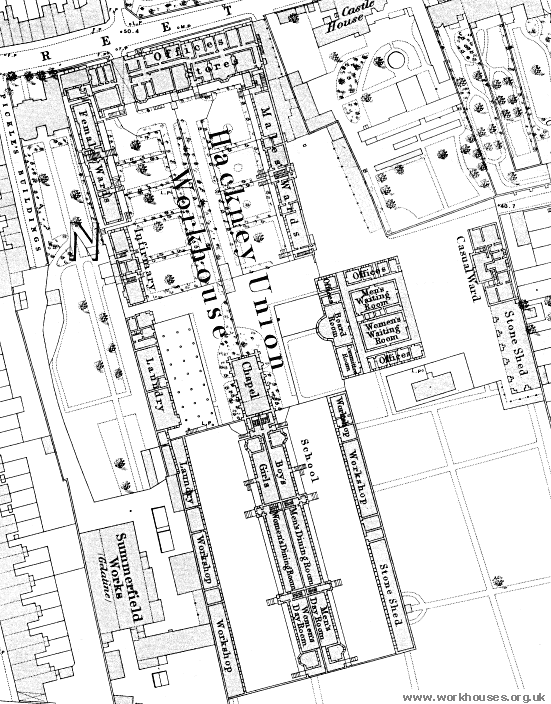
Hackney workhouse site, 1870.
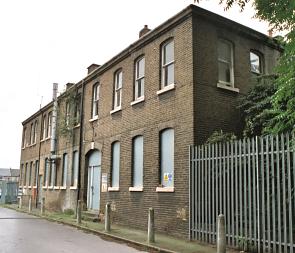
Hackney old administrative building from the north-west, 2001.
© Peter Higginbotham.
In 1866, following revelations in the medical journal The Lancet about the appalling conditions in London workhouses and infirmaries, the Poor Law Board carried out surveys of all the metropolitan workhouses. Part of its report on the Hackney workhouse is included below.
There are also large schools which, with the chapel, constitute a detached building ; and there is also a recently constructed iron house consisting of two rooms, in which the sick children are placed.
Cases of fever and small-pox are, for the most part, sent to the hospitals, but occasionally it becomes requisite to admit them, and a separate ward must be extemporized for their use. A few cases of venereal disease are admitted; and, on the men's side, they are placed in the itch ward, or in an adjoining ward, whilst the females are placed in a separate room. Violent and dangerous lunatics are not admitted except for the purpose of being forwarded to an asylum at the earliest moment. The inoffensive ones are retained, and occupy separate rooms.
There is no attempt to classify the sick into medical and surgical, or acute and chronic cases.
There are not any day rooms for the use of the sick, but there are some for the imbeciles. The lying-in ward is so small as to hold the labour bed only, and the cases are removed as soon possible to the convalescent lying-in ward. The latter, however, is not a day room, but a day and night room.
There is a kitchen in the sick ward where food is warmed, and chops and beef cooked, but the food must be carried, on the plates, more than 150 yards from the general kitchen. There are also three rooms where the washing-up is done.
The buildings are well drained. There is an abundant supply of good cold water, but hot water is not found upstairs except in the small boilers of the grates. There is only one fixed, and one portable bath.
There are 613 inmates, of whom 13 are able-bodied, 35 are imbeciles, and 119 are upon the books of the medical officer.
In the body of the workhouse, the usual height and width of the wards are 9 to 10 feet, and 16 to 17 feet. Hence the usual floor space and cubical space, are 41 to 59 superficial, and 395 to 590 cubic feet; and 13 of 21 wards do not offer 500 cubic feet, as required by the Poor Law Board. The itch ward is of very small capacity.
Nearly all the rooms throughout the workhouse are both low and narrow ; but as there are windows on two or three sides, they are all light, and if properly coloured and furnished would be cheerful. The staircases and corridors are also very small and narrow, and give a very confined air to the whole building. Certain rooms in the basement and even on the ground floor, as the male and female foul wards, are dark and cheerless. The rooms in the iron house are not satisfactory.
The bedding throughout the workhouse is fairly good. It consists of flock placed upon iron bedsteads, with iron laths or sacking. The rugs are of wool, and of red colour ; and the bed coverings are good. There is in general, a great deficiency of furniture, and an aspect of bareness and want of comfort. There are rooms without a dresser on which to place the crockery. There are no lockers for the inmates, and scarcely any chairs ; and such as are there, are for the most part old and repulsive. The tables are very small; the benches are similarly small, and without cushions; there are no looking glasses on the men's side, and no prints. We did not see any illustrated periodicals. There are games, as dominoes and draughts. There are also screens in some of the wards, and there also chest and foot warmers in all the wards.
The plates used are of tin, and are old and repulsive. Tin pannikins are also used instead of pottery mugs. The buckets and other large utensils, and even the swill tub (emptied and cleansed daily) are placed in the lavatories. There is not one room which has been coloured, but all are whitened. The windows on the sunny side have green blinds.
Three towels are supplied twice a week to a ward; and there are also to each ward a metal wash hand basin, two combs and soap ; but no hair brush is supplied to the adults.
The workhouse is generally clean; and with some few exceptions the linen and utensils are clean also.
Much pains have been taken to improve the ventilation of this workhouse. In nearly every room there are three sets of ventilators, viz., an Arnott's ventilator in the chimney; openings in the ceiling, which are covered with perforated zinc, and which communicate directly with the outer air, by air bricks in the walls, or shafts going through the roof ; and openings from the corridors and staircases, defended on the outside by metal, with large meshes, and on the inside by a wooden case which is intended to direct the current upwards.
There was also a system of ventilation by means of an open and perforated panel in the the doors ; but it has been abolished by boarding up the perforated zinc. In one or two places pieces have been cut out of the top of the doors; and in a few windows these are perforated panes.
But, notwithstanding all this, the workhouse is very ill ventilated. When we entered a room in which the windows were not open, the air was close ; and we were informed that in the early morning the air was very close. This is accounted for in several ways.
1. A majority of the ventilators are closed up ; and many of the Arnott ventilators are tied up. The ventilators in the ceiling are covered with paper ; or have been covered by flannel, to prevent too great a current of air. The wooden protectors of the ventilators from the corridors interfere too much with the entrance of air.
2. None of the ventilators open immediately into the outer air. Those in the ceiling have the nearest approach to this ; and when the wind blows in certain directions, the outer air bricks, or the chimneys in the roof, permit too strong a current of air, and thus defeat the object of those who-placed them there.
3. They are not sufficiently numerous.
4. The corridors and staircases are too much enclosed, and are not the great ventilators of the wards, as they should be.
5. The rooms are too full of inmates.
But whatever care may be taken in this matter, the result can scarcely be satisfactory, with rooms so low and narrow, and with corridors and staircases so small and confined. It will be difficult to introduce a sufficient quantity of air by ventilators to keep the wards sweet, without allowing the current to be felt by those who occupy the beds; but with an improved system, an extended plan, and constant ventilation by day and night the temperature would not be raised, as at present; and the inmates would be less sensible of the admission of the outer air. The rooms in the basement, and the two lying-in rooms, were perhaps the most close of any perceived by us. The windows are, for the most part, made to open by swinging on a central pin, and there are open fire-places. There are only two paid nurses in the workhouse, one of whom has only just been appointed. And it is intended that one shall have charge of the men, and the other of the women. The present superintendent nurse is also practically the midwife ; for although the medical officer is presumed to attend these cases, it frequently occurs that the labour is terminated in his absence. These receive 35l. and 25l. per year.
There is also a pauper nurse, and a helper, to each ward. Two men of this class receive 1s. and one 1s. 6d. each, weekly; and the woman who has charge of the receiving ward, with the itch cases, receives 1s. 6d. per week, besides extra food and stimulants. No special night nurses are appointed, except when any case is very ill. The matron distributes and administers all the wine and spirits, and the paid nurses are expected to give all the medicine.
The master is not dissatisfied with the present arrangement, and whilst the assistant to the medical officer does not think the pauper nurses truthful, he considers their conduct to be good, on the whole. He does nor think that any additional paid nurses are really necessary. There are, however, many important sick cases in the workhouse, which require attention during the night. The medical officer usually attends twice or thrice a week; and when an epidemic occurs he attends daily, or twice a day. His assistant attends at least twice a day ; and altogether about 1 , to 2 hours per day are devoted to the duties. There are usually about 150 cases upon his books; and of them about 100 are sick ; but nearly half of them are placed upon his books, that they may obtain meat or beer, or both daily.
The salary is 130l. per year; and the medical officer finds his own assistant, and all drugs, except cod-liver oil, and quinine. There is no extra fee for midwifery, or vaccination ; but 10s. 6d. is paid for each lunacy certificate. We were informed that, in his opinion, the guardians should provide drugs, pay extra fees for midwifery, and vaccinations, and give 150l. per year as salary. Subsequently we met the medical officer, and were informed by him that his salary should be 200l.
In the final quarter of the century, the workhouse accommodation was expanded, particularly that used for accommodating the sick. Two plain five-storey dormitory blocks were built at the south, either side of the main pavilion and administrative blocks. An extension to the administrative block was added to its south. Most significantly, a large pavilion-plan infirmary complex, designed by the union's architect William A Finch, was erected in several phases at the north-east of the site, one ward block in around 1882, and another in 1897.
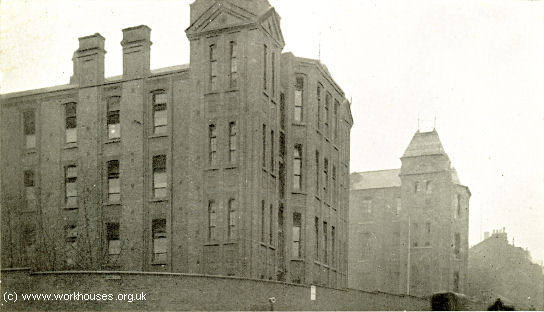
Hackney 1897 and 1882 ward blocks from the north-east, c.1912.
© Peter Higginbotham.
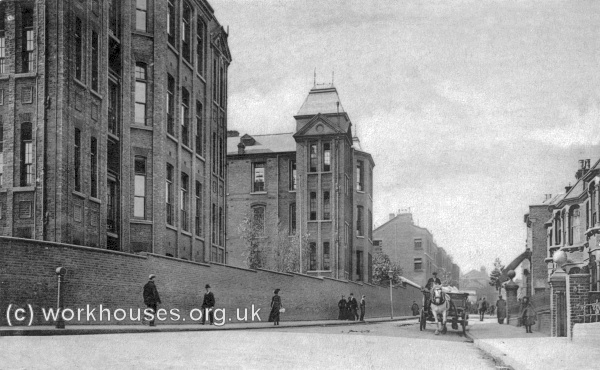
Hackney 1897 and 1882 ward blocks from the north-east, c.1910.
© Peter Higginbotham.
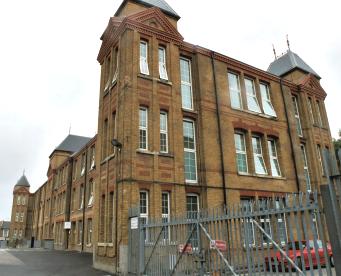
Hackney 1882 ward block from the south-west, 2001.
© Peter Higginbotham.
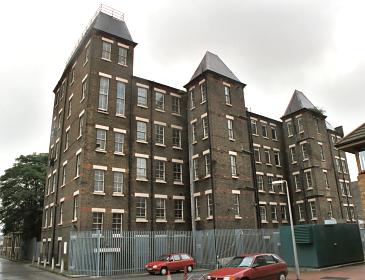
Hackney later dormitory block extension from the west, 2001.
© Peter Higginbotham.
In 1906, a new administrative block was built to the rear of the High Street frontage, with new receiving wards either side. The later layout is shown on the 1913 map below.
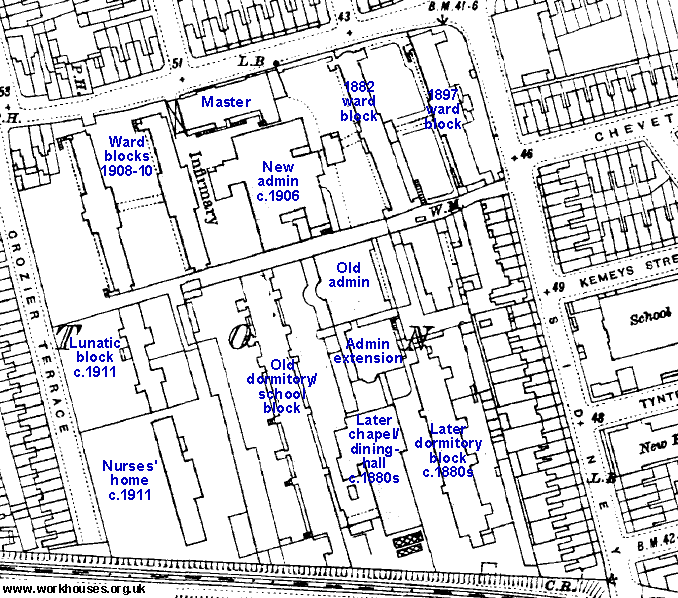
Hackney workhouse site, 1913.
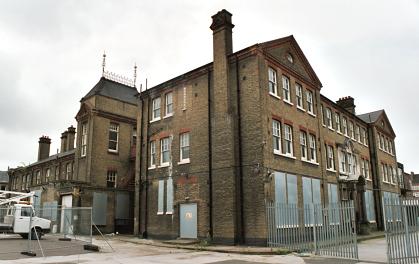
Hackney 1906 administrative building from the north-east, 2001.
© Peter Higginbotham.
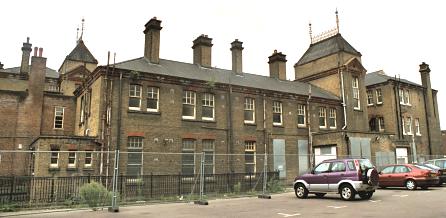
Hackney 1906 administrative building from the south-east, 2001.
© Peter Higginbotham.
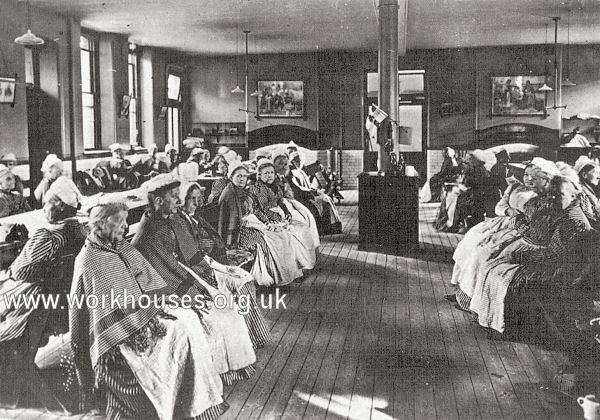
Hackney workhouse women's ward, c.1902.
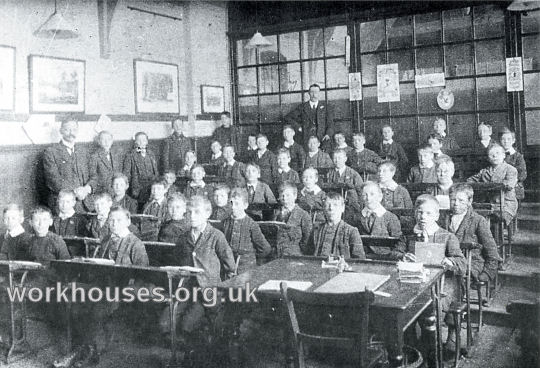
Hackney school-room, c.1900.
Two further infirmary pavilions were added at the north-west in 1908-10. In 1911, a single-storey lunatic block was added at the west of the site, and a four-storey nurses' home at the south-west.
In April 1930, the workhouse came under the control of the London County Council, becoming Hackney Hospital. The following Christmas, the hospital was rocked by the 'Hospital Death Dance' scandal. Nursing and other staff were holding a party in a corridor near to one of the men's wards. At 6pm, a nurse attending a dying man named Brooks left him to go to the party. Ten minutes later, Brooks — whose bed was screened off from the rest of the ward — began a ten-minute bout of wailing and screaming. No staff appeared and visitors to another patient in the ward eventually went to seek help. They stopped a nurse in mid-dance who, on hearing who the man was, told them they were talking nonsense as Brooks had died at 6pm. The visitors returned to the ward and Brooks again started wailing again and sounded as if he was vomiting. He also knocked a basin to the floor as he tried to reach for it. The visitors again went for help and, under protest, a nurse left the dance to look at Brooks but only stayed a few seconds. A few minutes later, Brooks groaned and gasped and appeared to be dead. After the visitors went among the dancers to tell them this, a number of them rushed to his bed. When the emerged from behind the screen, one of them told the visitors to mind their own business. However, they were so incensed by what they had witnessed that they contacted the John Bull weekly newspaper who reported the incident in great detail. It was said that someone from the hospital had gone around buying up all the copies of the newspaper in the area to try and suppress the story. The subsequent scandal ended in the dismissal of several staff and the banning of staff functions from being held the patients' areas of the hospital.
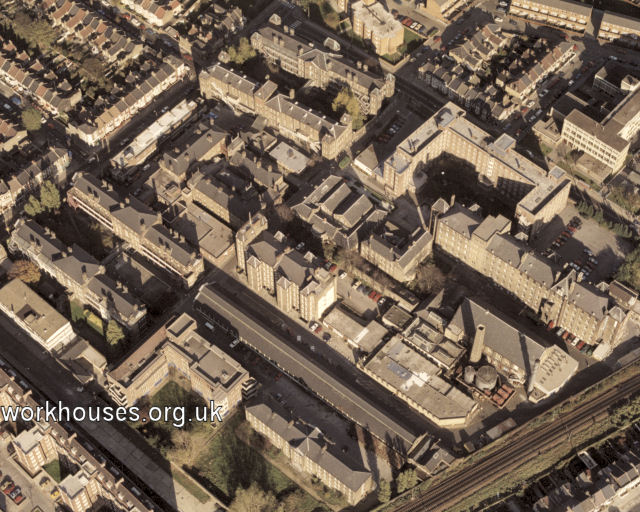
Hackney Hospital from the south-west, 1980s.
Following the opening of the Homerton Hospital in 1987, services were gradually transferred there from Hackney Hospital. The final hospital departments closed in 1995 and the site is in the process of redevelopment to become the John Howard Centre for Forensic Mental Health, with only the 1882 and 1897 ward blocks at the north-east of the site now surviving.
Gainsborough Road Casual Ward
From 1898 to 1904, Hackney developed a large casual ward complex on Gainsborough Road at Hackney Wick. The site provided overnight accommodation for vagrants, who also had to work in return for their accommodation. It was also a "labour test" site, where non-residential able-bodied paupers performed daytime work in order to gain poor relief. The buildings, again designed by William A Finch, included reception rooms, bathrooms, sleeping cells, work cells, workshops, a laundry, water tower, and administrative offices. The site location is shown on the 1913 map below:
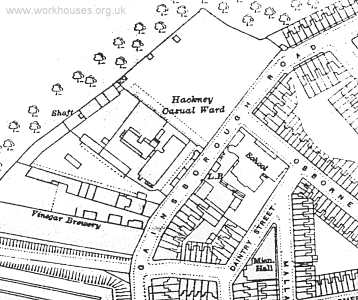
Hackney casual ward site, 1913.
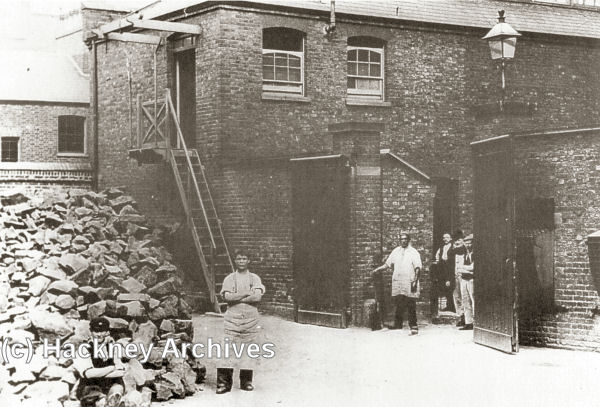
Hackney stone-breaking yard, c.1900.
© Hackney Archives, 2nd floor, Dalston CLR James Library and Hackney Archives, Dalston Square, London E8 3BQ.
Staff
Inmates
Records
Note: many repositories impose a closure period of up to 100 years for records identifying individuals. Before travelling a long distance, always check that the records you want to consult will be available.
-
The
Ancestry UK
website has two collections of London workhouse records (both name searchable):
- Westminster workhouse records are available on FindMyPast, .
-
London Metropolitan Archives, 40 Northampton Road, London EC1R OHB.
- Hackney workhouse — holdings include: Admissions and discharges (1867-1931); Creed registers (1893-1937); Deaths (1859-1934); etc.
- Hackney infirmary — holdings include: Admissions and discharges (1881-85).
- Brentwood Branch Workhouse — Creed registers (1908-26); Registers of inmates (1908-31).
- Children's Receiving Home, Sidney Road, Homerton — Creed registers (1900-31); Punishment book (1899-1930).
- Brentwood School — Creed registers (1877-1931); Registers of vaccinationss (1881-1906).
- Children's Home, Chipping Ongar — Admission and discharge registers (1908-39); Creed registers (1908-39); Baptisms register (1929-32); Deaths register (1910-12); Registers of apprenticeships (1909-33); Punishment book (1908-31).
- Other holdings include: Guardians' minute books (1837-1930); Staff records (1859-1939); etc.
-
St Bartholomew's Archives & Museum, West Smithfield, London EC1A 7BE.
- Holdings include: Infirmary admissions and discharges (1880-1); Creed registers (1905-10, 1929-30); Births (1876-1924, 1933-7); Deaths (1892-1901, 1904-17, 1919-83).
Bibliography
- Aronovitch, Bella (1974) Give It Time
- Montair, Paul (1995) Swelling Grounds
Links
- Hackney Archives, 2nd floor, Dalston CLR James Library and Hackney Archives, Dalston Square, London E8 3BQ.
Unless otherwise indicated, this page () is copyright Peter Higginbotham. Contents may not be reproduced without permission.


